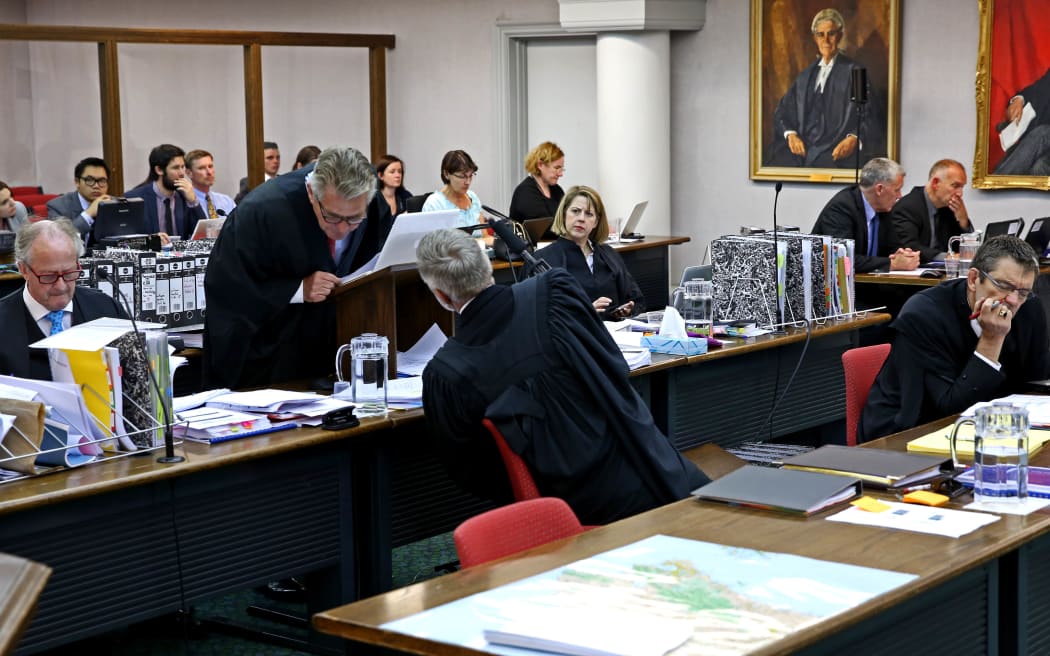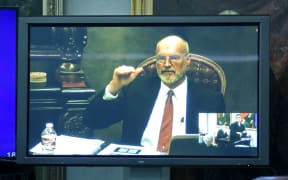The paint chips left in Christine Lundy's skull bones got there when she was forcibly hit with a painted object, a forensic scientist has told the High Court at Wellington.

Mark Lundy. Photo: RNZ / Alexander Robertson
Mark Lundy, 56, is accused of murdering his 38-year-old wife, Christine, and seven-year-old daughter, Amber. Their bodies were found in their Palmerston North home on 30 August 2000; the Crown claims Mr Lundy killed his wife for her insurance money and Amber because she saw what he was doing to her mother.
Key points from day 23:
Numerous blue and orange paint chips were found in the blood and pieces of skull washed from Mrs Lundy's body. They were also found in the sheet taken from her bed, and in "debris" taken from Amber's body.
The prosecution has previously told of Mr Lundy's habit of painting his tools with orange and blue paint to identify them as his own.
Institute of Environmental and Scientific Research scientist Sally Coulson, who specialises in trace analyses, looked at the paint chips and compared them to tools found in Mr Lundy's garage, and also to dark blue paint on an axe head or tomahawk.
Some matched the tools, while others did not.
However, to have become embedded in the bone as some were "a painted object or implement would have had to forceably strike the bone to get transfer of paint", she said.
Earlier in the trial, a defence witness said the paint flakes could have got into Mrs Lundy's hair when she went into the garage where the tools were kept.
Matter on Lundy's shirt 'definitely brain'
Earlier today, the court was told matter on Mr Lundy's polo shirt was "definitely brain" and one billion billion times more likely to be from his wife than anyone else.
Neuropathologist Daniel Brat, professor of pathology and laboratory medicine at Emory Healthcare in Atlanta, Georgia, this morning said he reviewed slides of the matter last year.
"... It was definitely brain," he said.
Cross-examined by Mr Lundy's defence lawyer, David Hislop, QC, Prof Brat agreed it was central nervous system (CNS) tissue - from the brain or spinal cord.
Prof Brat was the third American expert to testify that the matter was CNS tissue, from the brain or spinal cord.
Institute of Environmental and Scientific Research forensic scientist Susan Vintiner yesterday told the court that in 2001 she DNA-tested the two smears found on Mr Lundy's polo shirt. She found it to be 450,000 million times more likely to be from Mrs Lundy than from someone unrelated and chosen at random.
Today she told the court she retested those samples as part of the reinvestigation into the case in 2014.
Newer methods were used, and this time the matter was found to be one billion, billion times more likely to be from Mrs Lundy than from someone unrelated and chosen at random, Ms Vintiner said.

Mark Lundy's lead lawyer David Hislop Photo: RNZ / Alexander Robertson
Mr Hislop asked whether someone who had a heavy cold and who sneezed or coughed while ironing could leave their DNA on the item they were working on, and whether that DNA could stay on the item for some time.
Ms Vintiner said it was possible "subject, of course, to [the] shirt not being washed in the interim".
He also asked about DNA from an unknown person which also showed up on Mr Lundy's shirt in 2014 testing and prompted DNA testing of four women who operated machines at the United States laboratory which made samples from the shirt. None was a match for the unknown DNA.
Ms Vintiner said she believed the unknown DNA was the result of contamination which had occured after testing in 2001, as it was not there then.
She said the way another forensic expert who was yet to give evidence had interpreted DNA results from blood found in the shower of Mrs Lundy's brother, Glenn Weggery, was "very misleading".
That expert's report found the samples were 83 percent similar to Mrs Lundy and 88 percent to Amber - figures arrived at by measuring peaks in the samples.
"Personally I think it's a very misleading way of presenting the evidence," Ms Vintiner said.
That was because there was no proper way of looking at evidential weight, she said.
"If that was all that you needed to do then we could all be DNA experts.
"It's something that we would never do in our laboratory. You may make an observation ... but the important thing is to be able to present a statistic. If you cannot unravel the profile, then you are of no assistance in interpreting that mix."
Blood spots collected by tape lifts
Yesterday, Ms Vintiner said she also tested blood spots on the shirt which were not visible to the eye but were picked up by tape lifts - whereby sticky tape is applied to a surface to collect anything on it.
Those spots were 19 million times more likely to come from Amber than from someone unrelated and chosen at random, she said.
Blood smears found on a window at the Lundy home were also 450,000 million times more likely to have come from Mrs Lundy than from someone unrelated and chosen at random, while blood found at the home of Mrs Lundy's brother, Glenn Weggery, was from an unknown female. It did not belong to Mrs Lundy or Amber, she said.
Mr Lundy's retrial, before Justice Simon France and a jury of seven men and five women, is in its fifth week and is expected to go for at least eight.
*Clarification - For the avoidance of doubt, please note that Radio New Zealand reporter Sharon Lundy is no relation to Mark Lundy.

Mark Lundy's defense lawyer Ross Burns talking to Crown prosecutor Ben Vanderkolk during the trial last week. Photo: RNZ / Alexander Robertson



